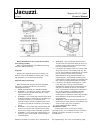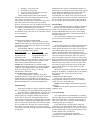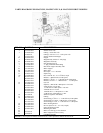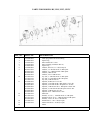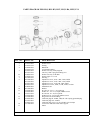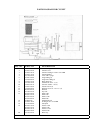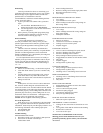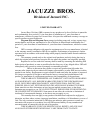
1. Drainage – away from pump.
2. Ventilation of pump motor.
3. Access for future servicing and winterizing.
4. Protection from the elements.
Pumps without strainer bodies are designed for
flooded suction (all suction fittings and suction piping
below water level) and will not self-prime.
Consequently, the pump must be installed at an elevation
that is below water level when pool or spa is filled;
however, if suction line valves are installed, the pump may
be closed for priming. Keep vertical distance to a minimum
if you choose to mount pump above water level.
Pumps with strainer bodies are self-priming but shoul
d
be mounted as close to the water level as possible or below
for ease in priming.
General Plumbing
FOR SOLVENT WELD CONNECTION
Rigid or flexible PVC pipe can be used. Pipe ends
should be clean and free of any flash cause by the cutting
operation. Be sure that the proper adhesive is used on the
type of pipe specified.
Recommended Adhesives – These are examples only
and are not intended to restrict brands.
PVC – PVC Joint
PVC – PVC Joint
Uni-Weld Pool-Tite 2000 Uni-Weld Pool-Tite 2000
Suregard Flex 20 Suregard Weld-All No. 5
IPS Weld-On 705 IPS Weld-On 794
Note: A primer will assure that adhesive joints are superior.
Suregard P-3000 has a purple tracer to qualify in areas
where codes specify a primer must be used.
Caution: We recommend that you consider climatic
conditions when applying adhesives. Certain atmospheric
situations, such as high moisture content, make adhesive
action of certain glues less effective. Check the
manufacturer’s instructions.
FOR THREADED CONNECTIONS
Use only Teflon tape or equivalent on threaded
plumbing connections. Other pipe compounds may damage
threads. We do not recommend the use of silicone or
petroleum based compounds. DO NOT OVERTIGHTEN –
HAND TIGHTEN PLUS ½ TURN IS SUFFICIENT.
Pump Plumbing
Suction pipe should be as large or larger that discharg
e
pipe. Avoid using suction pipe small that pump connection.
Keep the piping as straight and short as possible, and
of suitable size. Avoid connecting an elbow directly into
the pump inlet (use a length of straight pipe to allow a
proper entry for the water). Arrange horizontal runs to
slope upward to the pump to prevent high spots that could
form air pockets. Support the pipe independently so that it
places no strain on the pump. Keep as much of the suction
line as possible below the water level to reduce priming
time. Install valves and unions in the pump suction and
return lines to facilitate servicing. Valves are recommended
for throttling
maintenance if the system is installed below deck level.
Suction valves are essential for priming all pumps without
strainer bodies installed above water level. Pumps with
strainer bodies are self-priming, nevertheless, we
recommend the use of check valve in the suction pipe at
or below the water level if the suction lift is more that five
feet or if the dry suction is more that ten feet long. Keep
the valve in the suction line fully open during operation.
Electrical Data
Refer to information on motor nameplate fo electrical
service data. All motors should have fused disconnect
switch or circuit breaker. Be sure wire size is sufficient
for pump HP and distance from power source. Wiring
should be done in accordance with applicable codes by a
competent electrician.
We recommend the installation of a ground fault
circuit interrupter for maximum safety.
Pump Start Up
Do not operate pump until it has been primed as water
acts to cool and lubricate the seal. For pumps without
strainer bodies and locater above water, close suction line
valve and fill pump with water in order to prime. For
pumps with strainer bodies and located above water,
prime by removing strainer cover and filling strainer body
with water. Pumps located below water level will self-
prime if all piping is also below water level. After pump
has been primed, energize motor and open all suction and
discharge line valves. It may take some time for pump to
remove air from suction lines. If no flow is observed in
five minutes, stop the motor and re-prime. If the pump
fails to operate, check for air leaks. Refer to Trouble
Shooting section.
After about ten minutes of operation, check the return
fittings for air bubbles. A continuous flow of air indicates
leaks in suction line. Locate and correct any leaks
immediately.
CONTROLLING THE OUTPUT
Keep the gate valve in the suction line fully open
during operation. Should it be necessary to control the
output, use a valve in the return line.
Caution: Do not retighten strainer Ring-Lok during
operation.
Caution: Do not operate pump with closed suction or
discharge valves.
Two-Speed Pumps
Two-speed models are recommended in a swimming
pool when high speed is needed for maximum filtration at
peak periods and whenever turbidity levels are high. At
other times, switch to low speed. For backwashing and
vacuuming, high speed is required.
In spas and hot tubs, use high speed to attain full
performance in the hydro-therapy mode. At other times,
such as filter/heat cycle mode, use low speed. Low speed
provides sufficient flow to activate most spa heaters and
provides sufficient flow for filtration.
In jetted tubs, use high speed to attain full
performance in the hydro-therapy mode and use low
speed mode to prime.



